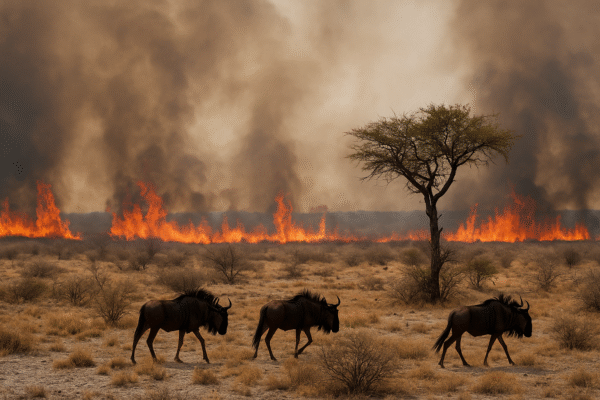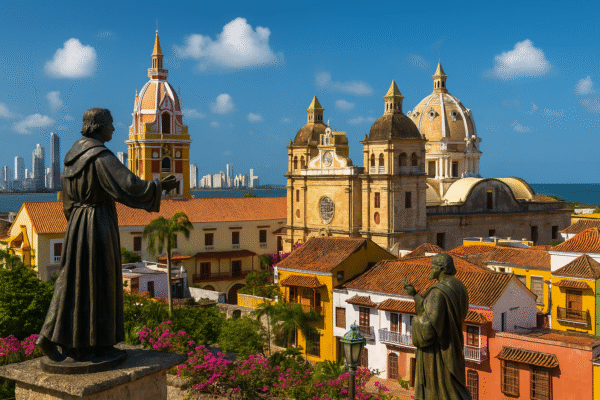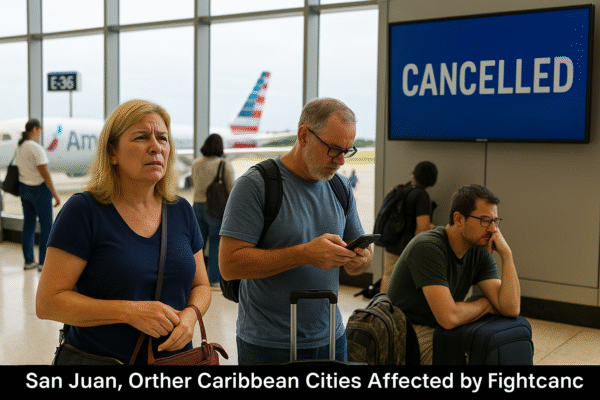A massive wildfire engulfed Etosha National Park on 22 September 2025, destroying over 775,000 hectares, nearly 34% of its land area. The fire spread rapidly through the dry savannah and shrubland, consuming habitats and forcing the closure of tourist routes. Etosha, known as Namibia’s crown jewel for wildlife tourism, has long attracted international visitors eager to spot elephants, black rhinos, and lions in their natural environment. Now, the disaster threatens not only biodiversity but also Namibia’s thriving tourism sector.
Economic Impact on Namibia’s Tourism
Tourism plays a vital role in Namibia’s economy, contributing significantly to employment and national revenue. Local businesses, from safari operators and hotels to restaurants and transport providers, depend on the steady flow of visitors. With safari trails closed and tours canceled, booking numbers have collapsed. Lodges that usually enjoy peak-season occupancy now stand empty, while tour guides and drivers face income losses.
The fire has placed thousands of jobs at risk and slowed down momentum in the sector’s post-pandemic recovery. Stakeholders emphasize that swift action is essential to restore confidence among travelers and prevent long-term damage to Namibia’s reputation as a premier eco-tourism destination.
Tourists Stranded and Plans Disrupted
Visitors from around the world traveled to Namibia for once-in-a-lifetime safari experiences. However, many have seen their itineraries canceled or rerouted. Safety curfews and firefighting operations have restricted access to popular safari zones, leaving travelers frustrated. Some tourists remain stranded in nearby towns, while others have shifted plans to alternative destinations.
For international visitors, the inability to witness Etosha’s wildlife spectacle undermines the purpose of their trip. Travel experts warn that negative visitor experiences could reduce future demand, as potential travelers weigh the risks of environmental crises against the appeal of Namibia’s wilderness.
Wildlife in Peril
The blaze has already killed antelope and destroyed large portions of habitat essential for elephants, predators, and endangered species like the black rhinoceros. Namibia has long built its global reputation on conservation success, yet the scale of this fire highlights the vulnerability of its ecosystems. Wildlife officials continue assessing losses while deploying teams to rescue and protect surviving animals.
Conservationists stress that habitat restoration will take years. Grasslands, shrubs, and watering areas crucial for survival have vanished, pushing herds into unfamiliar areas in search of food and shelter. This disruption threatens delicate predator-prey balances, potentially altering Etosha’s ecosystem for decades.
Government and Community Response
The Namibian government and park authorities launched emergency firefighting operations supported by local communities. Farmers and residents near the park volunteered equipment and labor, creating firebreaks and helping relocate animals. Tourism associations and conservation organizations are now uniting to develop recovery strategies.
Authorities have pledged stronger fire management plans, including early detection systems, controlled burning programs, and community awareness campaigns. These measures aim to reduce risks in the future and ensure Namibia’s protected areas remain safe for wildlife and visitors.
Long-Term Implications for Namibia’s Tourism Vision
Namibia has set ambitious goals under its Vision 2030 strategy, with eco-tourism positioned as a pillar of sustainable growth. Etosha stands at the heart of this vision, attracting thousands of international travelers annually. The wildfire, however, demonstrates the fragility of eco-tourism in the face of natural disasters.
Tourism leaders argue that recovery depends not only on rebuilding infrastructure but also on promoting Namibia’s resilience. Restoring damaged trails, reopening lodges, and reviving visitor services will help attract tourists back. At the same time, strengthening conservation programs ensures that Etosha retains its biodiversity, the main draw for safari tourism.
Building Resilience Through Fire Management
The crisis underscores the importance of investing in proactive fire management. Environmental experts advocate for creating permanent firebreaks, improving ranger training, and adopting modern satellite-based monitoring tools. Such measures would allow quicker responses and prevent blazes from reaching catastrophic levels.
Sustainable land management will also play a role in protecting Etosha and other conservation areas. Collaboration between the government, local communities, and international conservation groups will be essential to safeguard Namibia’s eco-tourism assets against climate-driven risks.
The Path to Recovery
Recovery requires both immediate action and long-term investment. Short-term priorities include reopening safe tourist routes, assisting affected businesses, and ensuring visitors can enjoy alternative Namibian destinations such as Sossusvlei dunes and Skeleton Coast. In the long run, restoring Etosha’s ecosystems will demand sustained conservation funding and strong community engagement.
Tourism boards have already begun campaigns reassuring potential travelers that Namibia remains a safe and rewarding destination. The call for responsible tourism encourages visitors to return once conditions improve, as their presence will help fuel economic recovery and fund conservation projects.
A Future of Hope and Sustainability
The Etosha wildfire has inflicted severe damage on Namibia’s environment and tourism sector. Yet, amid the destruction, resilience and cooperation have emerged. Local communities, conservationists, and tourism operators continue working side by side to protect wildlife and rebuild confidence.
With effective recovery plans and renewed commitment to conservation, Namibia has the opportunity to emerge stronger. Etosha’s story will not only reflect survival but also demonstrate how a nation built on eco-tourism can adapt, recover, and create a more sustainable future for generations to come.
For more travel news like this, keep reading Global Travel Wire

















